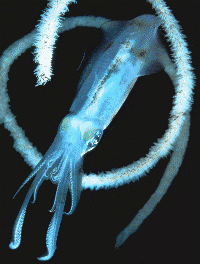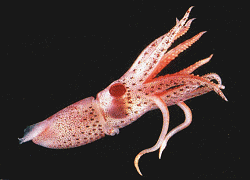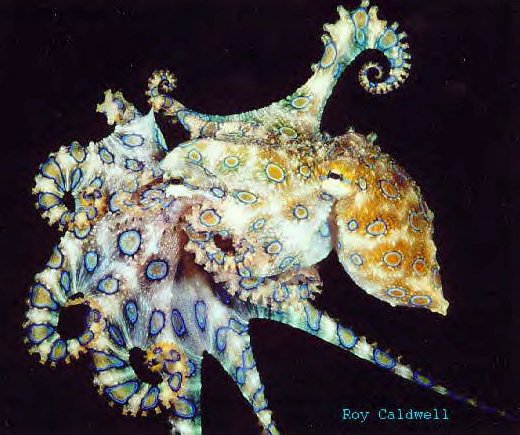What is this octopus thinking?
Are squid and octopuses really intelligent or have researchers been seduced
by their alien charms?
Garry Hamilton
WHEN an octopus in a research
laboratory in Naples learnt to choose a red ball instead of a white one by
watching another octopus, students of animal learning were taken aback. Such
"observational learning" is supposed to be seen only in higher vertebrates
animals such as rats with sophisticated brains - Octopuses, on the other
hand, are molluscs, a seemingly primitive animal group. True, octopus have
huge brains. But they look nothing like the brains of the vertebrates that
are so adept at learning.
For that matter, why would octopuses need to learn by example? They are
short-lived, solitary creatures that usually meet only once, to copulate.
Jean Boal, who studies animal behaviour at the University
of Texas in Galveston, epitomises the scepticism that greeted the announcement
in 1992 of the educable octopus. "If they really did show observational learning,
it would be astonishing," she said recently. "We have many mammals that aren't
doing that."
But not everyone is as doubtful. After all, the brains of animals like the
octopus evolved entirely separately from the brains of the vertebrates, and
they have an entirely different design - perhaps they also house a unique
form of intelligence. "We have two very different brains that can do some
similar things- including perhaps observational learning," says Shelley Adamo
at Dalhousie University in Halifax, Nova Scotia.
Others say that even if octopuses are incapable of something
as sophisticated as observational learning, they excel at other types of
behaviours that mainstream neurobiology has long since denied in so lowly
an animal. "It's very clear from a cursory observation of cephalopods that
they are extremely - intelligent animals," says Nathan Tublitz at the University
of Oregon in Eugene.
The debate about observational learning in octopuses is at the centre of
one of the oddest challenges in neurobiology: the quest to understand the
brain of the cephalopod, animals that include octopuses,
squid, cuttlefish and the single- shelled
nautilus. The weird construction of the cephalopod
brain was pieced together in the 1960s by J. Z. Young's classic studies of
the common octopus, Octopus vulgaris. But getting to grips with how
it works, and how well it works, has become fraught with disagreement.
Octopuses and squid are seductive creatures, so some critics
suspect that their intelligence has been grossly exaggerated by
anthropomorphising observers-"they watch my every move, therefore they must
be curious". On the other hand, because cephalopod behaviour and brain structure
are so foreign, others argue that their greatest cognitive feats are probably
still being overlooked.
Deep-sea brains
"They're very alien-an alien intelligence," says Adamo. "The way they 'think'
is very different. When you consider a cat, dog or rat, we pretend we can
sort of understand some of their responses. With cuttlefish, it's much more
difficult."
But it is becoming easier. The advent of cheap, compact underwater video
cameras makes it possible to chronicle the animals' behaviour in their natural
environment. Lab-bred squid and cuttlefish are also now available, making
them a far more convenient animal to study. Boal has even developed a
standardised aptitude test for octopus learning, which she plans to present
at this month's annual meeting of the Animal Behavior Society, to be held
at the University of Maryland in College Park; Armed with these new techniques,
researchers are laying the groundwork for what could be the first successful
attempt to get to the bottom of what it means to be a cephalopod.
Cephalopod lives are unlike those of their clam and slug relatives.
With the exception of the more primitive nautilus, these mighty molluscs
dart about by jet propulsion, hunt down living prey, including fish, squirt
ink and survive in a world filled with predators hungry for the taste of
calamari. Some species grow barely larger than a thumbnail. Others may turn
out to be the largest invertebrates ever to have lived. Take, for example,
the mysterious giant squid Architeuthis dux, which is known from carcasses
to be 18 metres long from tentacle tip to mantle, but has yet to be studied
alive. All told, there are roughly 700 species, and cephalopods can be found
in every ocean, from the tropics to the polar regions, from near-surface
reefs to depths of 7000 metres.
Cephalopods have boneless bodies and keen senses. Their complex
eyes, as large as car headlamps in some deep- water species, can distinguish
detail as well as mammalian equivalents. Although cephalopods are thought
to be colour-blind, they can see polarised light, which we cannot. They also
have highly developed senses of touch, taste and smell, and can detect gravity,
a sense which is used in the coordination of muscles during movement. And
in the past few years, researchers have even discovered what can best be
described as hearing: fine hairs along the head and arms that, in cuttlefish
at least, can detect disturbances made by a metre-long fish up to 30 metres
away.
"Researchers have discovered spines lodged in octopus brains,the result of a meal going the wrong way"
And yet despite the wiring required to process the input from
such a sensory smorgasbord, the brain itself promises so much more. At a
fundamental level- cells communicating by chemical signals and so forth-the
brain of the cephalopod is essentially the same as any vertebrate. Indeed,
research on the squid's "giant axon" has been instrumental in showing how
nerves work throughout nature.
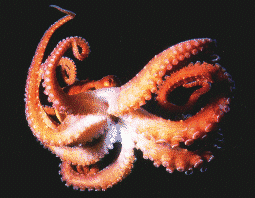 |
| Clever sucker: octopus can learn to distinguish objects of different shape,size and brightness. |
But not surprisingly, given that the common ancestor of the
vertebrates and the molluscs probably had no brain at all, there are also
some dramatic differences. The vertebrate central nervous system comprises
one main nerve cord that has swollen at one end to create a brain. Most molluscs,
on the other hand, have dual nerve cords running like a set of railway tracks
along the length of the body. These are dotted with five or six pairs of
ganglia, clumps of neurons that are capable of only the most primitive form
of information processing. In the cephalopods alone among the molluscs, evolution
has also constructed a brain. It has greatly expanded the forwardmost pairs
of ganglia and moved them closer together to create a tightly packed mass
of lobes that lies between the eyes and encircles the oesophagus. This is
an awkward arrangement in some ways - researchers have discovered spines
lodged in octopus brains, the result of a meal going down the wrong way.
"The brain is anatomically complex," says neuroscientist Ted
Bullock of the University of California in San Diego. "It is very highly
differentiated. It has a lot of texture, it isn't smooth or monotonous. It
looks like a complicated brain, histologically and microscopically." Make
no mistake, cephalopod brains cannot compare with the complexity of the brains
of mammals or even birds. In brain size to body mass ratios, however, they
outrank those of lower vertebrates, like reptiles and most fish.
Educating octopussy
"There is still this burning question out there about why this animal group
has such large brains," says Roger Hanlon, a cephalopod expert at the Woods
Hole Marine Biological Laboratory in Massachusetts. "We can't really explain
it-or the unbelievable centralisation and processing that you see in the
part of the central nervous system that we call the brain."
One answer could be that nature has been guilty of poor engineering: perhaps
all those neurons are merely the result of having a less efficient way to
handle the information needed to direct simple reflexes and process sensory
information. Another answer might be that the cephalopod is capable of extremely
complex behaviour that requires a lot of neurons for processing - a view
to which Adamo and Tublitz subscribe.
Among the most striking examples of what might constitute
complex behaviour is the way cephalopods alter their appearance. To avoid
being eaten, many species blend in with their surroundings by "posturing",
positioning tentacles to mimic floating sea grass, for instance, or by flexing
skin muscles that can
change the texture
and the colour of their skin. Indeed, cephalopods are unrivalled when
it comes to adopting new looks. They can adopt
patterns
that range from full-body speckles to dramatic black-on-white tiger stripes.
The more distinctive patterns are used as signals during courtship, hunting,
male-to-male aggressive encounters and in response to a threat.
Many animals change colour, of course, but usually by releasing
hormones that trigger the migration of pigment molecules within each cell.
In cephalopods, the ability is due to thousands, sometimes millions, of
chromatophores- multicelled organs that consist of pigment sacs of various
colours and muscle fibres that stretch the sacs when contracted. Because
the brain controls this through nervous impulses to the muscles, it takes
less than a second for cephalopods to adopt a new look. Hanlon recorded an
Octopus cyanea off the coast of Hawaii changing patterns nearly 1000
times during 7 hours of foraging.
The flashiest species are like swimming slide shows. One, the Caribbean reef
squid, Sepioteuthis sepioldea, has at least 35 patterns in addition
to its almost magical ability to blend with its background. It can flash
a different display on each side of its body when positioned between a potential
mate, which sees a uniform light grey, and a rival male, which sees tiger
striping called the "intense zebra display". If the positions change, so
do the patterns. Young cuttlefish sneaking away from predatory fish will
lie camouflaged against the bottom until algae and sediments are disturbed
by a breaking wave. Then, they ride the surging water, simultaneously adopting
a new pattern to match the swirling debris.
In the 1980s, the late Martin Moynihan, who worked at the
Smithsonian Tropical Research Institute on Barro Colorado Island in Panama,
went as far as to speculate that the Caribbean reef squid use their patterning
as a visual language- with different signals for nouns, modifiers and verbs.
Unlike octopuses, the reef squid live in schools and, Moynihan reasoned,
might need to communicate about, say, approaching predators. Moynihan was
struck by the richness of the squids' signalling repertoire. The patterns
even broke down into component parts that the squid used interchangeably,
providing an almost infinite number of signals - far more than any other
non- human animal, he claimed. The big hole in Moynihan's theory, however,
was that nobody knew what the signals meant.
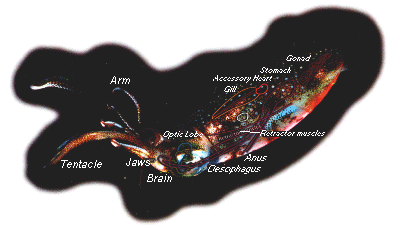 |
| Ink Spot : octopus and squid,like this coral reef squid,squirt black ink when startled. |
Happy hunting
If not processing a language, the cephalopod brain clearly exercises fairly
high-level control over the patterning process. Adamo is now trying to work
out whether this control is merely governed by reflexes to simple chemical
or visual cues, or involves some decision - making. When hunting, some species
of cuttlefish flash what is known as the "passing cloud display", a moving
pattern in which a patchwork of light browns is broken by waves of darker
brown that radiate along the body and down the outstretched tentacles.
"The octopus used its beak to bore a hole through the shell,then injected poison to weaken its victim"
The performance, which resembles light dancing on stones, is
thought to have a mesmerising effect on prey. It is also highly conspicuous.
So how do cuttlefish avoid becoming someone else's meal? To find out, Adamo
set up an aquarium in which common -cuttlefish, Sepia officinalis,
were free to hunt fish. When she passed a fake bird over the tank, the animals
stopped their hunting display. "They still hunt," she says. "But they don't
show it."
What took her by surprise was that not every animal reacted the same way.
"All of them stop doing the 'passing cloud' when the bird is present," she
adds, "but one does the coolest thing-he inks and then hunts under the ink.
The first time he didn't do it, but the second, third and fourth times when
the bird flies by, he secretes a bunch of ink and goes down into the substrate
and continues hunting." As Adamo sees it, such behavioural variability- both
between individuals and by the same individual at different times - hints
at the presence of a sophisticated brain.
Ivy League octopuses
And it is not only when it comes to patterning that the cephalopods show
a startling flexibility in their behaviour. Jennifer Mather, a psychologist
at the University of Lethbridge in Alberta, has studied how octopuses feed
on shellfish. In one strategy, the octopus uses its beak to bore a hole through
the shell near the abductor muscle. Next, it injects poison to weaken its
victim and then pulls open the shell. On other occasions, the same octopus
will simply yank the shells open, or smash them, or chip a little off the
shell's edge and inject the poison there.
"They're really being very flexible not just in terms of finding
their prey," says Mather, "but also in terms of how they get at the food
once they've got the prey - which we found very intriguing." Young's early
description of the octopus brain had certainly suggested a capacity for complex
behaviour-a theory that was tested in a series of experiments at the Naples
Zoological Station, culminating in the observational learning experiment
published in the journal Science in 1992.
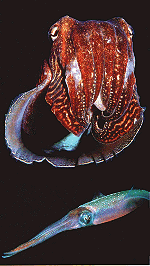 |
| Macho mollusc: the common cuttlefish's tiger striping (top) signals aggression. Caribbean reef squid (below) |
By giving octopuses a reward or a punishment when they attacked
different objects, Young, Martin Wells from the
University of Cambridge, and others
discovered in the 1950s and 1960s that the animals can learn to distinguish
between different shapes, orientations, sizes and degrees of brightness.
In one experiment, Young trained octopuses to select between large and small
squares, horizontal and vertical stripes, and black and white circles. He
found that the animals could retain all three preferences at once. In other
experiments, blinded octopuses learnt to distinguish between differently
shaped objects using only their highly sensitive suckers. One octopus remembered
the differences for four months.
"They learn these things rather faster than a vertebrate will
- a pigeon or a rat," says John Messenger, a
neurobiologist at the University of
Sheffield. "That is quite impressive." He also points out, however, that
although cephalopods learn faster at first, their skills level off. A trained
octopus will always make more mistakes than a trained rodent, he says.
Next, Young and Wells removed various parts of the octopuses' brains and
repeated the tests. That showed that learning is dependent on the bits of
the brain that lie above the oesophagus, particularly the vertical and superior
frontal lobes. In the 1970s, Messenger discovered that the speed with which
cuttlefish learn not to strike at prawns that are encased in a glass tube
increases during the first four months of life, correlating precisely with
the development of the vertical and superior frontal lobes.
But the 1992 "look-and-learn" study, by neuroscientists Graziano
Fiorito and Pietro Scotto at Naples, is the most controversial of all the
attempts to understand learning in cephalopods. To test if O. vulgaris
could learn a skill by observing the activities of other octopuses, the
researchers trained one group to choose a red ball or a white one.
When the trained animals reliably approached one or the other ball, untrained
octopuses were allowed to watch. When later presented with a choice of their
own, these animals not only selected the same ball more often throughout
the five days of the trial, but also learnt more quickly through observing
than the original subjects had under classical Pavlovian conditioning.
Astounding thought
"The rapid acquisition and the stability indicate that observational learning
in Octopus vulgaris is a powerful mechanism of learning," the researchers
concluded (Science vol 256, p 545). The finding was astounding not
least because observational learning is considered by some to be a preliminary
step to conceptual thought.
To critics such as Boal, however, the question isn't what kind of complex
learning cephalopods are capable of, but whether they're capable of it at
all. First, she says, there's the problem of why the solitary octopus has
evolved the capacity to learn by observing other octopuses. Supporters of
the idea of smart octopuses argue that other cephalopods form loose social
groups, so the octopus may have inherited its penchant for observational
learning from a common evolutionary ancestor.
Boal is not convinced. She has attempted to duplicate many
of the early learning experiments on octopuses, as well as perform similar
tests on lab bred cuttlefish, but with little success. "As I added more controls,
I got less and less evidence for learning," she says. "I found there were
a lot of places where people could have provided inadvertent cues to their
performance." For example, she says, sometimes the animals could see the
human researchers during presentation of objects. At other times, the researchers
failed to take into account the fact that the animals often have their own
unpredictable preferences for certain objects.
Late last year at Woods Hole, Boal, Hanlon and graduate student
Kim Wittenberg allowed animals to observe trained cuttlefish attack and eat
a crab, and then compared their performance in the same situation with a
naive animal. The observers did learn more quickly how to hunt down a crab.
But they also hunted better if they had previously seen only a crab without
a predation event, or even if they had simply smelt a crab that was kept
hidden behind a partition.
"If smelling a crab means you perform better than if you hadn't smelled one
before, and watching a predation event is no better than simply smelling
a crab," says Boal, "then we're not talking about complex learning. We're
talking about some kind of releaser of an innate behaviour."
"The new maze makes it possible to compare the same type of learning in octopus and rat"
Most researchers agree that understanding cephalopod psychology
is going to a require a thoroughly rigorous approach. For a start, the studies
should analyse types of learning and behaviour that might reasonably be expected
of cephalopods, even if they seem odd by comparison with vertebrates like
rats, the animals in which most learning studies have been done to date.
With that in mind, Boal is steering clear of tests of observational learning.
Instead, she has developed an apparatus to study cephalopod spatial learning,
the means by which animals find their way by remembering landmarks or the
distance they have travelled.
Cephalopods are certainly adept at navigation. Mather and a
team of volunteers have mapped the travels of fist-sized O. vulgaris as
they forage off the coast of Bermuda. The animals venture from their dens
on complicated trips lasting up to three hours, and return by different,
more direct routes. Although O. vulgaris usually ends up no more than
9 metres from home, other species of octopus can find their dens after journeys
of up to 120 metres -over a landscape that easily disorients human scuba
divers.
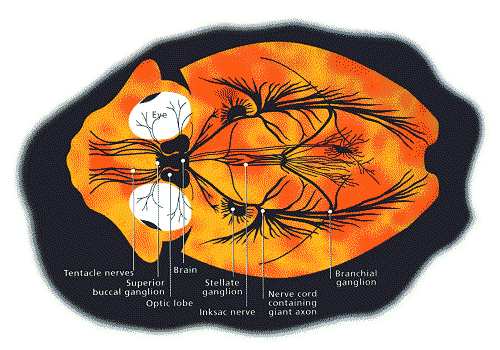 |
| Fish pieces: the central and peripheral nervous system of the cuttlefish. |
Octopus brainteaser
Boal's new apparatus comprises a well-lit circular tank with six den-like
holes, five of which are fake. The apparatus is based on the successful Morris
water maze for rats in which animals' abilities to remember the location
of a platform that lies just below the surface of coloured water is tested.
And just as rats in a Morris water maze will always try to get out of the
water onto land, octopuses will always try to escape from open spaces. In
her first test of the maze, Boal was able to demonstrate that the California
mud-flat octopus, O. bimacubides, learnt which hole was the correct
one within 20 trials, and sometimes as few as five, and that they remembered
its position for a week. "We don't know yet if it was learning a landmark
or spatial relationship. All we know is they did find their way back to the
same place quickly and efficiently," says Boal, who will present her findings
at the University of Maryland meeting.
Boal hopes that ultimately her octopus maze will become a
standardised test for working out how the cephalopod brain operates. For
example, neurophysiologists could use it to analyse the effect of removing
different parts of the animal's brain or chemically blocking different
neurotransmitters, and so get a far better idea of the similarities and
differences between the brain of a cephalopod and that of a vertebrate. For
the first time, researchers will also be able to compare directly the same
type of learning in the rat and the octopus.
But until fresh results. are in, the debate about the intelligence of the cephalopod will remain deadlocked. On the one side, researchers like Boal predict that the outlandish cephalopod will prove nowhere near as intelligent as the earlier studies claimed. On the other side are those who firmly believe it's only a matter of time before the depth and breadth of cephalopod psychology is finally revealed. "We have not come up with the right set of experiments to illuminate the intelligence these animals possess," says Tublitz. "The problem is the limitation of humans, rather than the limitation of the cephalopods."
